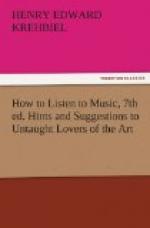But what shall the troubled critics say to Tennyson’s orchestra consisting of a flute, violin, and bassoon? Or to Coleridge’s “loud bassoon,” which made the wedding-guest to beat his breast? Or to Mrs. Harriet Beecher Stowe’s pianist who played “with an airy and bird-like touch?” Or to our own clever painter-novelist who, in “Snubbin’ through Jersey,” has Brushes bring out his violoncello and play “the symphonies of Beethoven” to entertain his fellow canal-boat passengers? The tendency toward realism, or “veritism,” as it is called, has brought out a rich crop of blunders. It will not do to have a character in a story simply sing or play something; we must have the names of composers and compositions. The genial gentleman who enriched musical literature with arrangements of Beethoven’s symphonies for violoncello without accompaniment has since supplemented this feat by creating a German fiddler who, when he thinks himself unnoticed, plays a sonata for violin and contralto voice; Professor Brander Matthews permits one of his heroines to sing Schumann’s “Warum?” and one of his heroes plays “The Moonlight Concerto;” one of Ouida’s romantic creatures spends hours at an organ “playing the grand old masses of Mendelssohn;” in “Moths” the tenor never wearies of singing certain “exquisite airs of Palestrina,” which recalls the fact that an indignant correspondent of a St. Louis newspaper, protesting against the Teutonism and heaviness of an orchestra conductor’s programmes, demanded some of the “lighter” works of “Berlioz and Palestrina.”
[Sidenote: A popular need.]
Alas! these things and the many others equally amusing which Mr. G. Sutherland Edwards long ago catalogued in an essay on “The Literary Maltreatment of Music” are but evidences that even cultured folk have not yet learned to talk correctly about the art which is practised most widely. There is a greater need than pianoforte teachers and singing teachers, and that is a numerous company of writers and talkers who shall teach the people how to listen to music so that it shall not pass through their heads like a vast tonal phantasmagoria, but provide the varied and noble delights contemplated by the composers.
[Sidenote: A warning against writers.]
[Sidenote: Pedants and rhapsodists.]
Ungracious as it might appear, it may yet not be amiss, therefore, at the very outset of an inquiry into the proper way in which to listen to music, to utter a warning against much that is written on the art. As a rule it will be found that writers on music are divided into two classes, and that neither of these classes can do much good. Too often they are either pedants or rhapsodists. This division is wholly natural. Music has many sides and is a science as well as an art. Its scientific side is that on which the pedant generally approaches it. He is concerned with forms and rules, with externals, to the forgetting of that which is inexpressibly nobler




